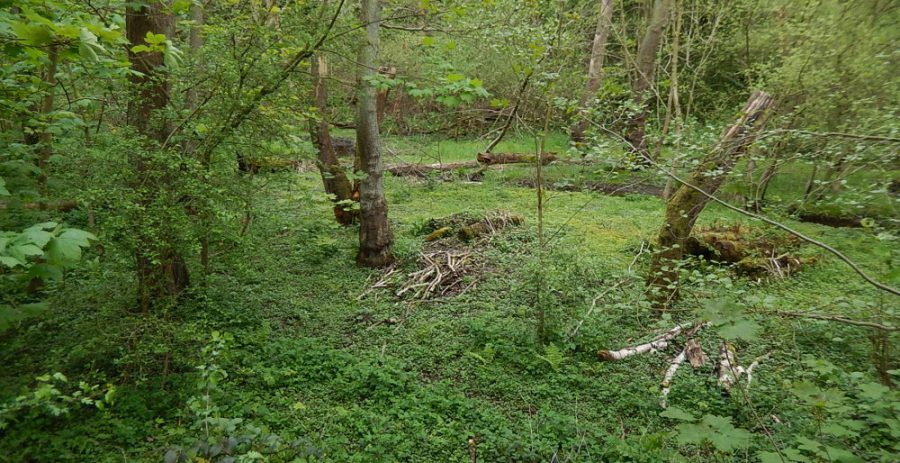
Introduction
New Dam was the last mill dam to be built in the Rivelin Valley. It was built in the 1850s solely to provide supplementary water to Spooners Wheel (next downstream) and so had no water wheel or associated workshops.
In 1909 New Dam was turned into an open air swimming pool. This closed in the late 1930s. The pool was drained and has become colonised by trees, but a small stream still flows through.
The Rivelin Chair Sculpture sits on an island on what remains of the New Dam weir.
History (C. 1853–1930s)
Main trades: Extra water supply for Spooners Wheel, swimming pool.

As its name implies, the New Dam was the last mill dam in Rivelin to be constructed (possibly the last in Sheffield). It is the only one in the valley without an adjacent waterwheel. It was built in the early 1850s to provide a supplementary water supply for Spooners Wheel due to a demand for more water. The existing Spooners head goit was widened and water fed into the Spooners mill dam by means of an underground tunnel through the high bank between the two dams.
The mill dam was fed via a weir and very short head goit at the western end.

In 1909 Sheffield Corporation turned the New Dam into an open air swimming pool– this was for men and boys only, although this rule was apparently widely ignored! However, being set so low down in the valley the water was always cold and only the most hardy could stand it for more than a couple of minutes. The pool had a swimming attendant and a woollen costume could be rented from him for a penny. The pool also had quite a lot of fish in it – if you caught one of these fish and placed it in a bucket at the side of the office you would receive your penny back. The pool closed in the late 1930s when the long wooden shed that was used as changing facilities was destroyed by fire.
What's there now?
The drained mill dam is well-wooded and has a stream flowing through. The weir, now marked by the Rivelin Chair sculpture (see below), is in poor condition. Water enters the short head goit at an inlet marked by massive stone blocks beside the footpath. Walk up the slope a short distance and look back to see grooves in the stonework for the wooden boards of the shuttle gate that used to control water flow into the head goit. The stone blocks and the original shuttle mechanism can be seen in a photo on the History page.
At the eastern end of the mill dam, the footpath crosses a small metal bridge over the overflow from New Dam; water from the stream flows out of the dam at the deep drainage level and drops steeply into the river via a very short channel. Look over the railing (on the mill dam side) and straight down to see grooves in the stones on either side of the channel at the deep drainage level – these are guides for the shuttle gate, which could be raised to drain the water out of the dam for maintenance. Just to the right of the overflow are the remains of the sluice that controlled the flow of water into the tunnel to Spooners Wheel mill dam.
From the south side of the river can be seen the remains of two foot bridges built in the early 20th century for better access to the swimming pool. On the north bank of the river, two short lines of Privet bushes border a path from the edge of the remains of the eastern-most bridge. This marks the location of the turnstile for the swimming pool. By the 1970s, the bridges were in a poor state of repair and were removed.
The Rivelin Chair sculpture sits on an island on the remains of the New Dam weir. The cast iron chair is crafted to appear like a seat made of coppice wood to reflect the thriving coppice industry that existed in the valley even before the watermills. It was designed and produced by local artist Jason Thomson who wanted to reflect other pieces of ironmongery around the valley left behind from the mills, and the twisted tree roots winding around the old dam walls. It was installed in June 2011, by Sheffield City Council.
Nature and wildlife at Walkley Bank Tilt
The mill dam is now mainly dry, apart from a stream running through to the overflow, and there are some quite large Alder, Ash, Oak and Sycamore trees – all developed over the last 75 years or so. Look out for Celandine, Enchanter’s Nightshade, Golden Saxifrage and Himalayan Balsam in the ground flora.
Between the path and the river is an extensive stand of an introduced garden species, Lesser Periwinkle, the blue flowers of which can be seen in spring and early summer. There is also a lot of Privet and Ground Elder in this area.
The damp walls of the head goit provide a good habitat for Hart’s Tongue Fern and at the river’s edge near the weir is a stand of Pendulous Sedge. A little further upstream Wood Melick and Yellow Archangel can be found on the bank on the north side of the path.
Dippers and Grey Wagtails are often seen along this shallow stretch of the river.
